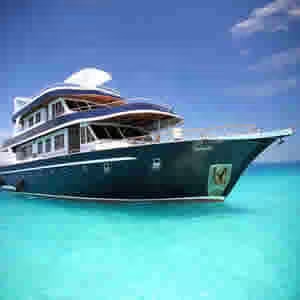Dangerous Fish in The Maldives
Aggressive species of Fish Hazardous to Humans
August, 2019
Dangerous fish in the Maldives? Of course there is, but in the last ten years only a few accidents have occurred. Sharks, despite their bloodthirstiness and a large number of divers never attacked people in the Maldives archipelago. These predators are very easy to spot there are places known for their presence, but a meeting with a shark does not mean close contact or attack. Usually circling around you they go to the blue waters.
Even if sharks are known to attack humans, they have never shown active behavior against humans unless you first try to touch or feed them. Young sharks are quite easy to find in the lagoons: they do not pose a danger to people, trying to stay away from swimmers. You should always remember that sharks should not be disturbed, fed to them or caused by any kind of aggression by their behavior. Small or large, sharks are primarily animals and must be respected.
Since sharks are not so dangerous, let's talk about marine life that can cause trouble to snorkeling and diving enthusiasts. Some sea creatures have darker, more terrifying aspects. A select few of these may attack human beings, while others might deliver a dose of poison when handled carelessly. Some species are maligned due to their shocking appearance or by their ferocious reputation in folklore and myth; however, one species, though cute and tiny, threatens bathers in a very, shall we say, personal way.
So many dangerous creatures live in the Indian ocean but this is not enough strong reason to keep us away of snorkeling and diving. It is very easy to keep you safe if you follow some little rules and investigate by yourself which are the most dangerous animals around the dive sights of your area. In the Maldives we can assure you that you will find more friendly rather than dangerous creatures.
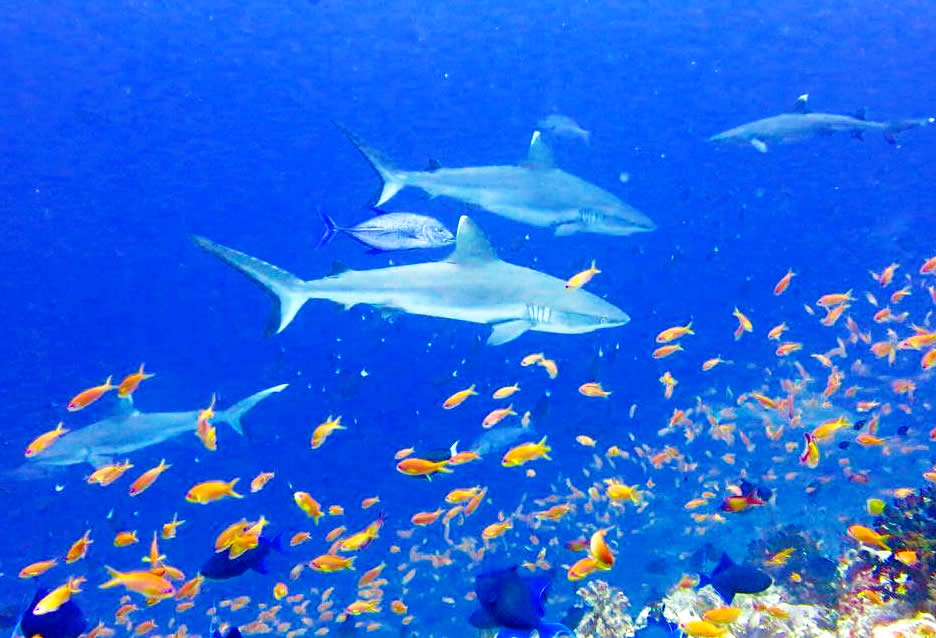
Lionfish
The Lionfishes, also known as zebra fish, or Striped Lionfish (Pterois volitans) is a fish of the Scorpion fish family. According to different species, family members have different aspects. Also called 'Lion Fish', it has a large pectoral and dorsal fin, painted in a striped color. They are noted for their venomous fin spines, which are capable of producing painful, though rarely fatal, puncture wounds. Severe pain is followed by a worsening of the condition, which ends with paralysis of the skeletal and respiratory muscles, which not rarely can cause death. The fishes have enlarged pectoral fins and elongated dorsal fin spines, and each species bears a particular pattern of bold, zebralike stripes. When disturbed, the fish spread and display their fins and, if further pressed, will present and attack with the dorsal spines. One of the best-known species is the red lionfish (Pterois volitans), an impressive fish sometimes kept by fish fanciers. By and large, this fish is very calm, and can be dangerous only if you disturb or touch it.
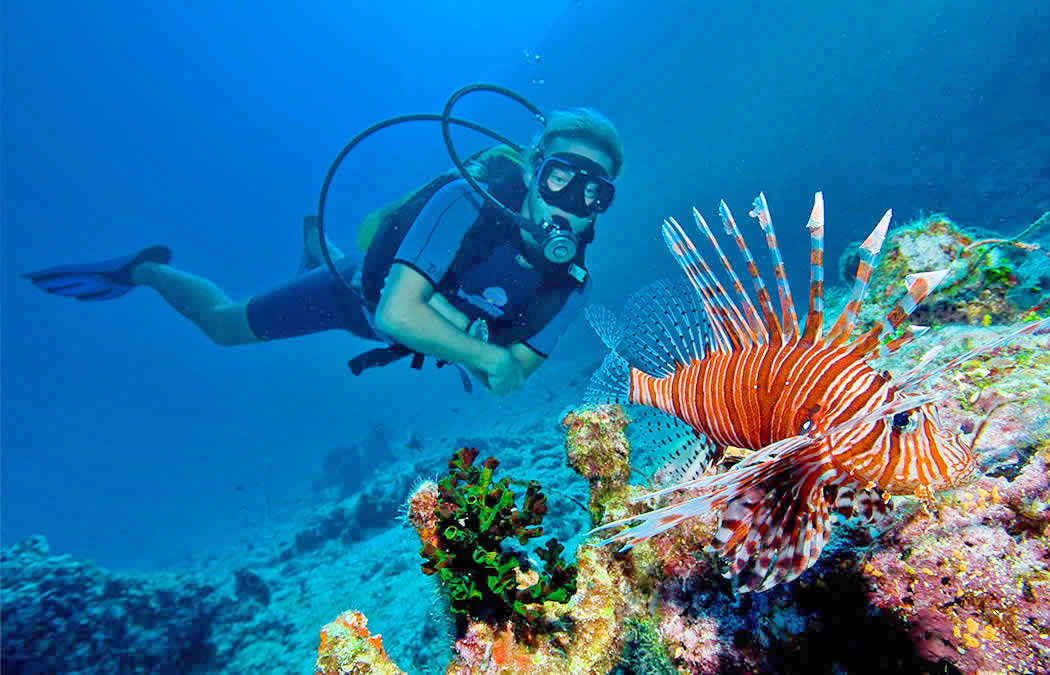
Moray Eel
The Eels family (Muraenidae), due to its appearance has gained a negative reputation. Species such as: laced moray, barred thucklip moray, giant and gray moray (Favagineus, Gymnothorax Javanicus, Gymnothorax Undulatus, Siderea Grisea) are easy to spot during snorkeling and diving in the Maldives. Moray eels are usually vividly marked or colored. They generally do not exceed a length of about 1.5 meters (5 feet), but one species, Thyrsoidea macrurus of the Pacific, is known to grow about 3.5 meters (11.5 feet) long. Moray eels differ from other eels in having small rounded gill openings and in generally lacking pectoral fins. Their skin is thick, smooth, and scaleless, while the mouth is wide and the jaws are equipped with strong, sharp teeth, which enable them to seize and hold their prey (chiefly other fishes) but also to inflict serious wounds on their enemies, including humans. Despite large teeth, the moray eel is a very calm fish, whose negative reputation is probably earned from its awesome appearance: the animal must constantly keep its mouth open for proper breathing. They are apt to attack humans only when disturbed, but then they can be quite vicious.
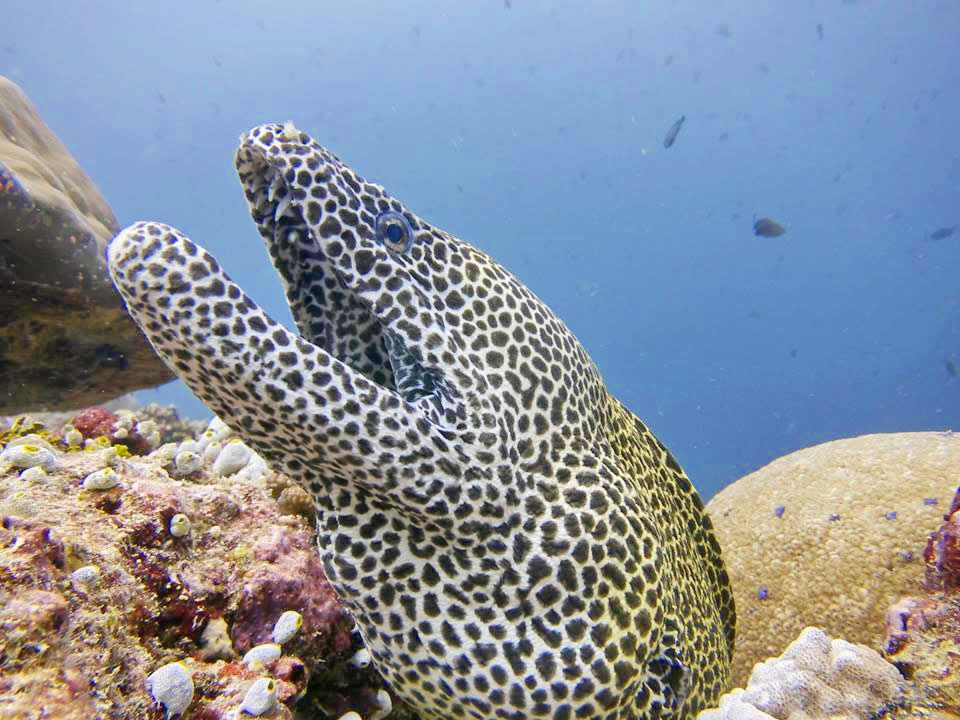
Great Barracuda
Reaching 2 meters in length, the Great Barracuda (Sphyraena Barracuda) also known as the giant barracuda belongs to the Sphyraena family and usually lives in shallow water. In some cases, large specimens can weigh up to 23 kg. Having a head with a massive lower jaw full of sharp teeth, some species of barracuda can be dangerous for people. They are scavengers, and may mistake snorkelers for large predators, following them in hopes of eating the remains of their prey. Barracudas may mistake things that glint and shine for prey. Diamond rings and other shiny objects have been known to catch their attention and resemble prey to them.
While barracudas display a disconcerting habit of curiously following divers and swimmers, attacks on humans are rare. Oftentimes, an attack consists of a single strike in which the fish attempts to steal prey from a spear, or else mistakes a shiny object for a fish. While serious, attacks are almost never lethal, bites can result in lacerations and the loss of some tissue. Considering its predatory aspect, handfeeding or touching large barracuda in general is to be avoided.
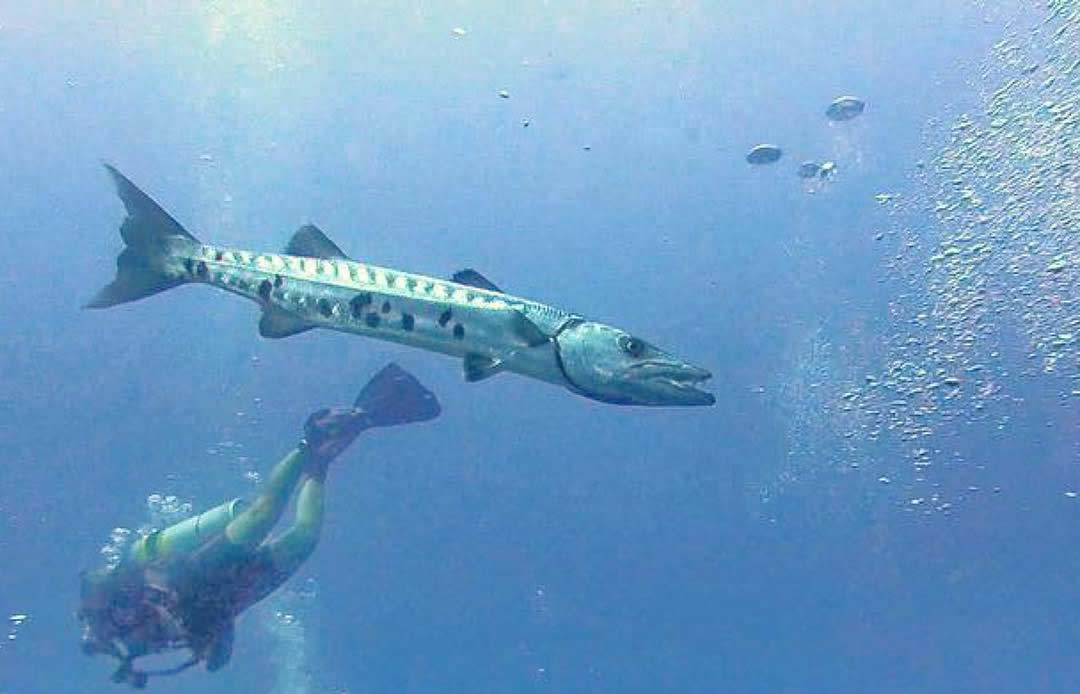
Giant Triggerfish
A large species of triggerfish found in lagoons and at reefs to depths of 50 m (160 ft) in most of the Maldives. The titan triggerfish or giant triggerfish (Balistoides Viridescens) reaches a length of about 75 cm, and weighs up to 10 kg and can simply bite you. It is quite impressive in size and has powerful teeth. Although bites are not venomous, the strong teeth can inflict serious injury that may require medical attention. The titan triggerfish is usually wary of divers and snorkelers, but during the reproduction season the female guards its nest, which is placed in a flat sandy area, vigorously against any intruders. The threat posture includes the triggerfish facing the intruder while holding its first dorsal spine erect. If you get too close, the fish begins to swim around you, and take a horizontal position. At this time you must leave this place immediately. The titan triggerfish will not always bite, but can swim at snorkellers and divers escorting them out of their territory.
Stonefish
Synanceia verrucosa is a fish species known as the reef stonefish. Stonefish is the most venomous fish in the world! There are 5 species of stonefish that can be found in the region of Indian ocean. This stonefish is usually brown or gray, and it may have areas of yellow, orange or red. Size of stonefish depends on the species. It usually reaches 14 to 20 inches in length and up to 5 pounds in weight. Stonefish are masters of camouflage and can blend in so perfectly with their surroundings that their prey, predators, and even divers have trouble seeing them at all. They almost always sit perfectly still, on the sea floor, in their preferred habitat of coral and rocky reefs, and their colors are often a perfect match for the substrate. Some species have even been observed with algae growing on them. While this camouflage gives them further protection from predators, its primary purpose is to allow stonefish to ambush their prey.
Dorsal fin of stonefish is modified into 13 spines. Venom is produced in the gland located in the base of each spine. Venom will be released after application of pressure (after stepping on the fish hidden in the sand, for example). Stonefish erects these spines whenever it is threatened. The most dangerous: stone fish (Synanceia verrucosa), false-stone-fish (scorpaenopsis diabolus) and leaf-stone-fish (Taenianotus triacanthus), whose camouflage is quite extraordinary. Venom produced by stonefish induces severe pain, paralysis and tissue necrosis. Since it may lead to heart failure, quick medical help is essential. Complete recovery requires adequate amount of anti-venom. Unlike other species of fish, stonefish is able to survive 24 h outside the water. Another interesting characteristic of stonefish is that it can spit water. Thanks to the coloring, they are not easy to find, so do not touch the corals with parts of the body, do not grab your hands and do not sit on them - respect the ecosystem and think about your safety.
Surgeonfish
When diving or snorkeling, you can see school of fish belonging to the Acanthuridae family. They are Dussumier, a blue-celled Thompson, yellow surgeon fish (Acanthurus Dussumieri), Acanthurus Leucosternon, Acanthurus Lineatus, Acanthurus Thompsoni, and Acanthurus Triostegus and Acanthurus Xanthopterus. Surgeonfish, also called Tang is 15 to 40 cm long, but there are also species up to 1 m. The body is tall, strongly flattened laterally. Eyes set high, mouth small.
The distinctive characteristic of the family is the scalpel-like spines, one or more on either side of the tail ("thorn tails"), which are dangerously sharp. The dorsal, anal, and caudal fins are large, extending for most of the length of the body. The fish use their weapons defensively though, as they are strictly vegetarians. Their spines may cause deep penetrating wounds but Surgeonfish do not have venom or toxin associated with them. When disturbed, a Surgeonfish will raise its razor sharp spines, sharp enough to cause serious injuries to divers and snorklers who get in the way but Surgeonfish tend to ignore divers and move away when approached.
Blue-Ringed Octopus
Blue-ringed octopuses, comprising the genus Hapalochlaena, are four highly venomous species of octopus that are also found in tide pools and coral reefs in the Indian ocean. They can be identified by their yellowish skin and characteristic blue and black rings that change color dramatically when the animal is threatened.
They are recognized as one of the world's most venomous marine animals. Despite their small size—12 to 20 cm (5 to 8 in)—and relatively docile nature, they are dangerous to humans if provoked and handled because of their venom, which contains the powerful neurotoxin tetrodotoxin. The attack of this little creature can be deadly so beware because the effects of its bite are catastrophic. Furthermore, there is no antidote. The poison is contained in the octopus’s saliva. The Blue-Ringed Octopus uses it to attack its preys but if divers come close to one of these animals in the wild, they can be attacked.
Bluespotted Ray
The bluespotted ribbontail ray (Taeniura lymma) is a species of stingray in the family Dasyatidae. Found from the intertidal zone to a depth of 30 m (100 ft), this species is common throughout the Maldives in nearshore, coral reef-associated habitats. As a form of warning others, the Bluespotted stingray generally displays its bright blue colored spots as a warning to predators of its highly venomous sting.
Stingrays are one of the most common groups of fish responsible for human envenomations; largely because many rays bury themselves on the seafloor where people unintentionally step on them. While timid and innocuous towards humans, the bluespotted ribbontail ray is capable of inflicting an excruciating wound with its venomous tail spines Stingray venom is generally cardiotoxic.
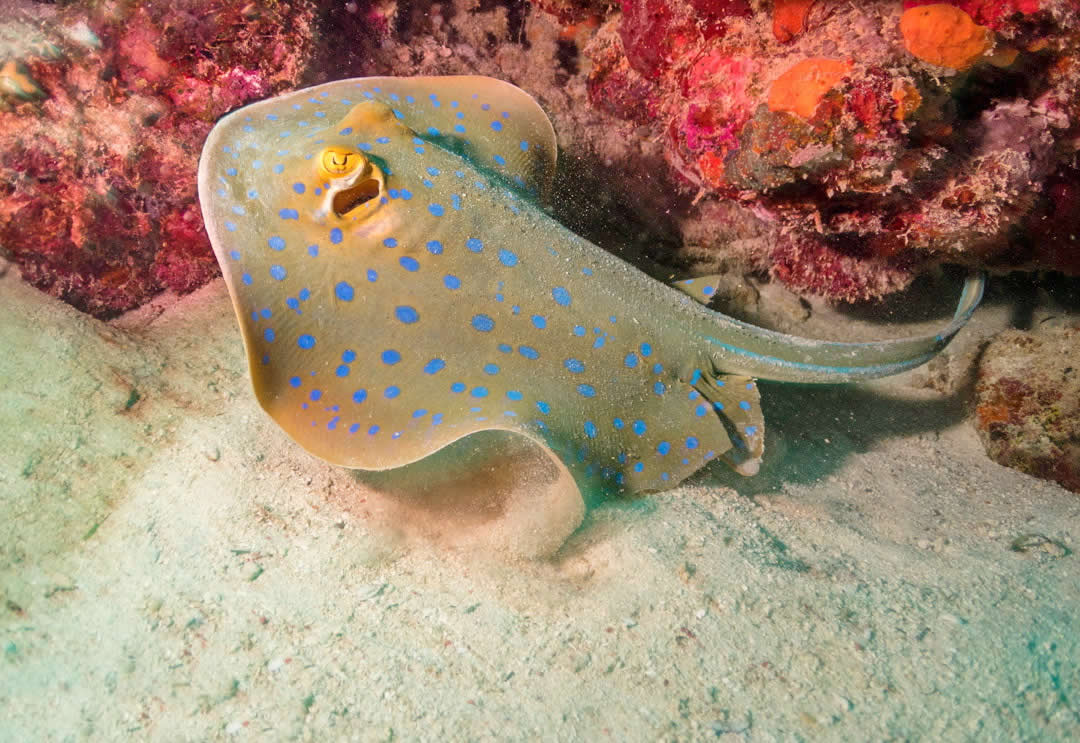
Fire Coral
Another unexpected but dangerous life in the ocean is the Fire Coral (Millepora) that are a genus of colonial marine organisms that exhibit physical characteristics similar to that of coral. The name coral is somewhat misleading, as fire corals are not true corals but are instead more closely related to jellyfish and anemone, making them hydrocorals. These organisms can deliver a power sting with its tentacles. Upon contact, an intense pain can be felt that can last from two days to two weeks. In addition, fire corals have a sharp, calcified external skeleton that can scrape the skin. As a scuba diver you should be aware as to Fire Coral looks like and that is why we have chosen a very good picture of the Fire Coral.
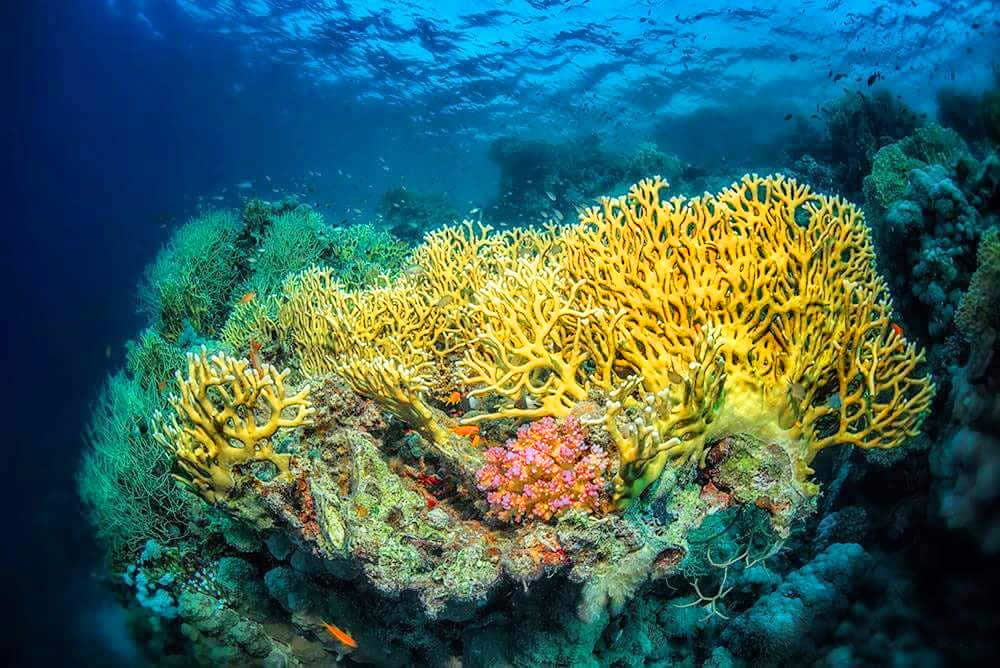

Beach or Water Villa?
Maldives - a name that became synonymous with honeymooners' paradise in the tourism world, has slowly revamped to cater to the needs of families visiting
Read More
Best Maldives Resort Offers & Packages
Find out more about the most unparalleled Maldives hotel deals and special rates, when Book Direct your next beach holiday
Read More
Maldives Hotel Reviews
Some of the best hotels and resorts in the Maldives are already included in this list, and the good part of them offers the best prices. We will constantly add new hotels
Read More
10 Exclusive Resorts in Maldives
The Maldives is paradise destination that should be on the bucket list of every discerning travelers. There's a special breed of hotels there that cater to the most tasteful of luxury travelers Read More

The Maldives’ Hottest Luxury Hotel Openings for 2023
Here are just 10 of the amazing new resorts in the Maldives that are set to welcome guests Read More

10 Most Affordable Water Villas
While it may never be cheap to visit thу Maldives, fortunately there are still some chic and relatively affordable overwater villas you can stay. Read more

Maldives Luxury Guide
Here's the best of Maldives for luxury travellers. We've compiled the finest recommendations of places to stay, ranging from the most celebrated five-star resorts to luxurious private islands Read More

Maldives Romantic Guide
The ultimate ‘flop and drop' and honeymoon destination, the Maldives is the playground for the most amazing and finest utilization of each second of this extremely valuable and hopeful time with each other in tota Read More

Maldives Budget Guide
Budget travellers choose Maldives as their destination of choice thanks to the variety of affordable stays Read More

Maldives Family Guide
Maldives - a name that became synonymous with honeymooners' paradise in the tourism world, has slowly Read More

Maldives Diving Guide
The life of these paradise islands below the Indian Ocean's level is the main draw attracting thousands of divers Read More



















